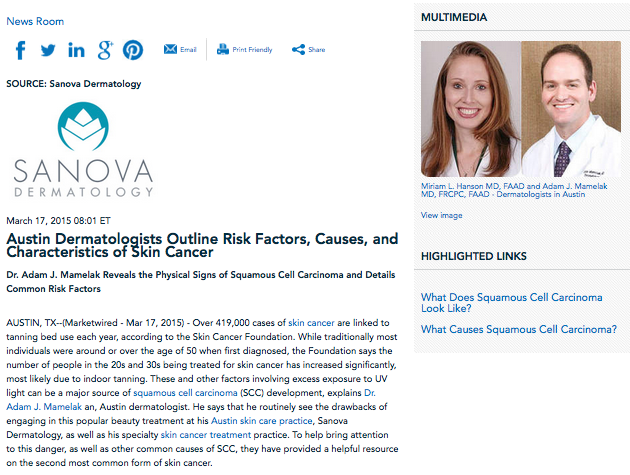
Dr. Adam J. Mamelak reveals the physical signs of squamous cell carcinoma and details common risk factors.
Austin, TX—Over 419,000 cases of skin cancer are linked to tanning bed use each year, according to the Skin Cancer Foundation. While traditionally most individuals were around or over the age of 50 when first diagnosed, the Foundation says the number of people in the 20s and 30s being treated for skin cancer has increased significantly, most likely due to indoor tanning. These and other factors involving excess exposure to UV light can be a major source of squamous cell carcinoma (SCC) development, explains Dr. Adam J. Mamelak an, Austin dermatologist. He says that he routinely see the drawbacks of engaging in this popular beauty treatment at his Austin skin care practice, Sanova Dermatology, as well as his specialty skin cancer treatment practice. To help bring attention to this danger, as well as other common causes of SCC, they have provided a helpful resource on the second most common form of skin cancer.
Often preventable, many of the causes of SCC are the result of spending too much time in the sun without protection, which includes sunscreen, hats, and sunglasses, notes Dr. Mamelak. Many individuals have jobs that require them to be outdoors for most of the day, or they may engage in recreational activities that expose them to harmful UV rays and forget to take precautionary measures, he continues. Not all skin cancer influencers will be as avoidable, he cautions. Patients with fair hair and skin and light eyes are more vulnerable than others with darker coloration, and he reminds people with immune disorders or sun-sensitive conditions to be especially vigilant in their care.
One of the best ways to maintain health is to regularly undergo skin care screenings by a board-certified dermatologist, Dr. Mamelak suggests. In between examinations, he urges patients to inspect their skin for physical signs of SCC or other concerns. He explains that individuals may be able to recognize the condition by the scaly lesion or wound-like appearance of the ulcers, which may itch, bleed, or feel tender to the touch—though not always. When in doubt, he emphasizes, always seek out a qualified physician for a professional opinion.
Ultimately, Dr. Mamelak believes that when well informed about the possible dangers of tanning bed use and excess sun exposure, patients will choose to protect their skin and make healthier, safer decisions. He also hopes that by providing comprehensive information on SCCs individuals will be able to recognize and obtain treatment for skin cancer before the problem becomes dangerous.
About Sanova Dermatology
Directed by two board-certified dermatologists, Adam J. Mamelak, MD and Miriam L. Hanson, MD, Sanova Dermatology offers a broad range of innovative cosmetic and general dermatology procedures, including Mohs micrographic surgery, reconstructive surgery, acne treatments, dermal fillers, and laser skin rejuvenation, to current and prospective patients in the Austin area. Founded on the principles of compassionate care and excellence in service, the dermatologists believe patient education can lead to happier, more satisfied people and improved outcomes. Dr. Mamelak and Dr. Hanson are available for interview upon request.
For more information about Dr. Mamelak, Dr. Hanson, and Sanova Dermatology, please visit sanovadermatology.com, facebook.com/sanovadermatology, or twitter.com/DrAdamMamelak.
Contact:
Sanova Dermatology
Plaza North Building
12319 North Mopac Expy., Ste. 100
Austin, TX 78758
(512) 837-DERM (3376)
Rosemont Media
(858) 200-0044
www.rosemontmedia.com


